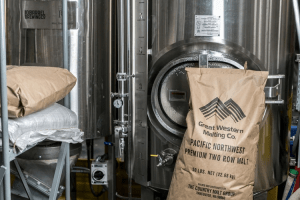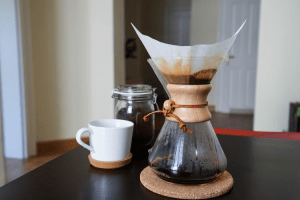
If you wish to simply make brew it’s done with a brief list of ingredients: water, yeast, hops, and malt grain (most possible barley). These are identical ingredients employed by the large guys. This listing sounds simple enough. The reality is, creating a brew has equal components science and art; those latter two are the key ingredients of creating brew. merely giving an individual an easel, brushes and paints doesn’t build that person an old master. If you wish to form a fine brew you wish to know the science behind ingredients and the way to place them along.
However, that excellent brew is regarding balancing flavour, aroma, bitterness, and mouthfeel. In making an attempt to attain any optimally balanced brew, interpreting, and tweaking an instruction is regarding understanding this science and art.
Today some are taking their art in new directions by experimenting with ingredients that are outside the standard box. For instance, some are exploitation pine, fir, and spruce shoots to feature bitterness and a few completely different aromas to beer. however this follows dates to colonial times, thus it’s not entirely new. My in-law told ME there are brewers experimenting with exploiting grape skins for his or her tannins to feature bitterness to brew.
When it involves discussing beers, it does not take long for the conversation to come back around to hops. within the wine business, it’s regarding grapes. And yeast is the mystery ingredient; it’s harder to know yeast. Most of us have seen footage of acres of hops growing or the mesmeric form of the hops cone, however, we have a tendency to ne’er see the yeast as a result of its one cell organism.
Hops primarily exist for transmission bitterness. There are two primary acids in hops-alpha and beta. The alpha acid brewers the bitter style profile. The second acid fills out the bitterness. Traditionally the antimicrobial compounds in hops helped preserve brew. This was a very important attribute for hygienical and preservative reasons at that point. It’s laborious to believe brew has been around since four,000 before Christ and recorded history of hops indicate they were utilized in 700 AD and therefore the English were drinking brew with hops in 1400 AD.
As an aside, yeast has been around for an equally very long time. It’s simply that it absolutely was not discovered till the 1800s.
In addition to hops, there is an excess of yeasts to decide on from. The sheer variety of types of hops and yeast strains stagger the imagination, along with they provide limitless flavours, aromas, bitterness, and mouthfeel choices.
“Americans have been growing hops since early colonial times, simply not the quantity of types mature nowadays. The primary business N. hops production was a 45-acre garden established in 1648 to produce a distillery within the Massachusetts bay settlement”, notes Hops Growers of America. If you’re interested in a lot of hop facts, think about these:
889 plants or “hills” form up one acre of hops.
In the pacific northwest, yields average two,000 pounds of dried hop cones per acre on mature hop yards, or a touch over 2 pounds per hill (yields vary betting on selection and location).
Hops are generally oversubscribed in 200-pound bales (of course those are serious production operations).
A bale can yield between one hundred thirty-five – 800 barrels of brew (31 gallons during a barrel), betting on the instruction.
Source: Hop Growers of America
When an individual discovers that excellent brew, that can most likely be short-lived; preferences do amend. Like wine customers, brew style preferences do amendment that motivates customers to explore new offerings. Further, the sheer magnitude of flavour variations can foster experiments for new beers. Who would have pictured a paste Stout or exploitation pine shoot or grape skins to form beer?
One amendment ongoing is that the non-alcoholic brew class. This trend has not figured out well for wine, however, we are going to see regarding brew. Alcohol will impact flavour which may be a massive issue whether or not it’s wine or brew.
As the previous expression goes-Nothing is simple and if it were everybody would be doing it. production is not any exception, a small change/misstep in execution or ingredient choice may result in unmotivated consequences. If there are any doubts, acquaint yourself with the story of the death of the most important American brewery within the 1960’s-Schlitz-The brew That created the urban centre known.
Tragically, once senior management changes, the new management team thought they may save cash by exploiting cheaper ingredients and using short-cuts in production. (Ultimately, they were suspected of selling “green” brews due to shortened fermentation times.) the consumer instantly recognized some changes within the product and didn’t just like the changes. It absolutely was shortly before customers understood one thing was wrong with their favourite brew. This incident validates another adage: If it is not broken do not fix it. unmotivated consequences.
Deciding what’s the simplest brew may be a subjective call. I did some analysis a number of years past and located there have been seventeen completely different issues that came into play choosing what wine was a human favourite. Basically, such things as atmosphere, age, experiences with varied wines, influences from others, visits to wineries, mouthfeel, aromas, etc. fashioned a human preference. Brew isn’t that abundant, completely different once it involves subjective choices on its ideal brew.
The current trend in the brew is the hoppy forward sensory perception of bitterness also as taste/flavour. For shoppers demanding the contemporary bitter style of hops, choosing the proper hops varietal is vital. The selection of hops to induce that right level of bitterness is several. It’s the high acid content in individual species of hop cones which will deliver that precise bitter style. Then the trick is to decide on the hops which will deliver the desired aroma profile.
The numeric worth of bitterness is that of the IBU variety. The IBU scale is from one to one hundred. It’s the bitterness introduced into the brew from the hops that regulates the specified sweetness within the product.
“Just as there are dozens of grape varietals used for trade, there are a lot of various types of hops on the market to brewers. And a bit like with wine grapes, hops {of {different|totally completely different|completely different}|of various} strains and from different growing regions bring different flavors, aromas, and bittering capabilities,” comments Caitlin at KegWorks 2017.
America and Germany at the mecca of hip development and analysis. In the US, the middle of the hop world is Washington, Idaho, and Oregon.
Hop varieties even have a pedigree and growers thrive on the name close to the standard of their hops, the higher the hop pedigree and a grower’s name, the bigger the demand. As in most things, demand drives the value. It’s speculated that some hop varietal cones have oversubscribed for a high of $20-25 per pound. the typical in 2019 seems to be $5.68/pound. Last year growers within the United States created 113.5 million pounds of hops which is a rise of nearly ninetieth over 2012 and a seven.5% increase over 2018.
The impact of hops on the brew creating method is actually determined by the fashion. A rough rule of thumb is two hundred pounds of hops (1 bale) makes twenty barrels.
Here may be a breakdown, by style, of hops (in pounds) utilized in manufacturing a typical keg of brew (1,984 ounces):
- Amber 0.17
- Brown ale 0.52
- Imperial IPA three.80
- IPA 1.00
- Pale Ale 0.56
- Stout 0.30
- Source: Hop Growers of America
Lastly, the essential oils in hops dictate the aroma value, in conjunction with some support from yeast. These oil esters are distinctive to every type of hop. Some oils can manufacture floral, citrus, or earthiness tones. there’s an associated form to operate with the essential oils to bring out the specified aroma. Too much heat for too long can destroy the aroma esters in hops. Brewer expertise appears to be a big consideration transferral out the character of essential oils.
There are approximately eighty active sorts of hops to decide on from and a lot of are being developed perpetually. The particular count of hop varieties is also nearer to a hundred and eighty. This is often like grape varietals in winemaking; there are many varieties that are planted, and a lot of are being developed by universities and labs everywhere on the planet. In 2019, the United States was the most important producer of hops followed closely by Germany.
Simply put, hops is split into 3 main categories: bittering, aroma, and dual. Bittering hops tend to own a high quantity of acid in them and impart that recognizable bitter flavour onto the brew. Aroma hops have less acid however a lot of pronounced flavour and aroma and are accustomed to build the brew style and smell a particular manner. Most brew recipes demand each type of hops. Twin hops tend to have a mid-range to the high quantity of acid and a decent smell and aroma and might be used for each aroma and bittering. If you wish to brew a brew with simply your native hops, one in all these twins hops plant varieties may be a good choice,” says Liz Baessler. opt for your hops showing wisdom.
Moving to the topic of yeast.
Yeast, one cell organism, is employed to show the varied sugars in malt grain/wort into alcohol. The importance of yeast analysis is illustrated by conjointly watching the wine trade. As an example, in 2019 a university in Spain claimed to have developed a yeast strain that would impart identical style and aroma as aging wine in an oak barrel. This points out the flexibilities yeast brings to the table relative to fermentation. Imagine a microscopic cell has this abundant influence on creating alcohol, CO2, the myriad flavour and aroma choices and mouthfeel in the brew.
“Yeast may take credit for the classification of the brew designs. Brew masters decide a yeast per the instruction or the fashion of brew they need to form. Yeast is known as either a beer yeast or a beer yeast,” per brew cartel weblog.
Yeast may be a complicated ingredient in the brew. There are many yeast strains utilized in the brew and every one offers its own temperament and characteristics. Some are specifically suited to consume choose sugars within the wort and a few have stronger endurance to perform that task.
Today there are several makers of pure brewer’s yeast strains. It’s vital to understand yeast conjointly happens naturally within the atmosphere and wild yeast is not essentially smart in production. For this reason, early brewers had real issues with the dominant consistency of the performance of their yeast. Yeast is added once the wort boils (with the hops) and once the wort has cooled (temps are settled by style). Yeast is thus vital that some brewers are terribly secretive regarding the yeast selection they use.
Yeast bought for home production is usually oversubscribed by the number of cells during an ampul or package. For instance, a little bag of a pure yeast strain can contain one hundred million cells which would typically be enough for five gallons of a finished brew. The retail value is $10.00.
Dr Linda Bisson has spent an abundance of her life doing analysis on yeast. Dr Bisson says there are thousands of yeast strains and plenty of strains are present within the wild. As mentioned previously, the largest contributor to mouthfeel is the manner in which specific yeasts react with specific sugars within the wort- specifically dextrin sugars.
People have asked if bread or wine yeast may be employed in brew fermentation. The short answer is not any, a minimum of not much. However, a lot of educated answers are from men. Denny Conn, “You will use any quiet yeast to ferment a brew, however the matter lies within the results. Wine/champagne yeast ferments totally different clusters of sugars. (The subject of sugars could be a complicated subject once it involves yeasts overwhelming the sugars in wort.) Wine yeast doesn’t ferment malt simple sugar, one in every of the most sugars in brew wort. The results that you are left with brew that does not quite style like brew.”
“Hops tend to urge all the beauty and a spotlight currently, I powerfully believe that the $64000 stars of the show-what makes brew fascinating, delicious, and maybe even nutritive, is yeast,” says Joseph Lavoie-Beer Crafter (sic). Lavoie explains that before prizefighter Pasteur’s add yeast analysis within the middle 1800s, brewers knew that they had to use the leftover sediment from the previous brew to create the following batch, they merely failed to are aware of it was yeast that created brew concoction return to life.
According to “Beer Magazine”, totally different yeast strains behave otherwise, which makes it attainable to divide the planet of brew per the yeast. Sixty or many outlined brew designs will all be sorted by their yeast into 2 broad families: the beer family of yeasts and the larger family-top zymolysis (cooler temps) and bottom fermenters (warmer zymolysis temps) severally.
To illustrate simply how complicated the choice of yeast has become, I visited an oversized manufacturer of brewer’s yeast and counted their yeast offerings for creating some common designs. Here is what I found: yank Ale-32 varieties; British Ales-45; Belgian bitter Ales-26 and IPA-36.
Here could be a sample profile they provide to assist in choosing a yeast.
WYEAST yank beer #1056
Type: Liquid
Flocculation: Low/Med
Attenuation: 73-77%
Temperature: 60-72°F, 15-22°C
Flavour: Exceptionally clean, crisp flavour characteristics with low fruitiness and delicate organic compound production. a really versatile yeast for designs that want dominant malt and hop character. This strain makes a beautiful “House” strain. delicate citrus notes develop with cooler 60-66°F (15-19ºC) fermentations. ordinarily needs filtration for bright beers.
Because wort sugars are ready-made for yeast, one in every one of the complexities of production is knowing the myriad sorts of sugars and their chemical structure. Wort is what offers yeast a foundation to bring brew into its own. The topic of the link between sugars and yeast is awfully complicated.
Noted earlier, yeast conjointly contributes to beer’s flavours and aromas. It can also aid in creating brew clear through the method of activity. Inactivity yeast cells kind along and settle/drop out deed brew clearer. Further, yeast will highlight the maltiness and aroma profiles whereas adding to the fruitiness that hops imparts. Yeast will impact sweetness or dry sensation and mouthfeel within the end. Mouthfeel could be a vast sensory queue in appreciating a fine brew.
Because yeast and hops do similar things relative to flavour and aroma, it’s necessary to grasp however every sort of hops and yeasts can impact a method. If you actually wish to fancy the expertise in overwhelming a fine brew completely, it’s useful to a minimum to perceive a number of the sciences.
In the 1880s individuals isolated a pure strain of yeast that was appropriate for larger production, as opposition ales. This can be an example of why analysis is usually moving ahead in yeast development. Even the Golden State Gold Rush-era miners recognized the special characteristics of bread created by a bakeshop in a metropolis. The Boudin family created a special breadstuff employing a special yeast the family discovered.
Beer is exclusive unto itself as a result of craft can and is being made for regional and national markets. We tend to fancy the brews with new flavours and aroma square measure thanks to the power in beer creating processes and ingredients. New designs have brought brew into new social settings. deem seeing brew as a middle piece at food pairings, even fine feeding institutions, and social occasion gatherings.
Mr Koch of the state capital brew Company has created a brew that he says can rise up to any champagne. “Champagne style with a brew budget? fortunately, these days, you do not have to be compelled to pay many bucks to sip that sweet vino – if truth be told, you’ll have constant champagne style and mouthfeel in your favorite form of brew,” says Kaitlyn McInnis-Editor, Ask Men.
“Thanks to the increase in craft brew, a lot of and a lot of breweries square measure experimenting with funkier ingredients and production strategies, as well as victimising champagne yeast in their brews! This out-of-the box production leads to a constant umami-packed style you’re keen on in champagne except for a fraction of the value,” says McInnis.
Different Beers, totally different Strokes for All the people!
Read our blog on Top Tips From an Expert to Help With Home Brewing





